There are two things I love to nerd out about — communications theories and Star Trek.
That’s not as random as it sounds, I swear.
My obsession with Starfleet began when I was small. Growing up in a house full of nerds, watching Star Trek and eating pizza was a family Friday night tradition. My obsession with studying the patterns of how people interact, and, well, communicate came later, which is one of the main reasons I attended grad school.
In the book Third Place Learning: Reflective Inquiry into Intercultural and Global Cage Painting, Dr. Glyn Rimmington and Dr. Mara Alagic use a metaphor called “cage painting” to illustrate the challenges and opportunities for learning when two people are from different cultures or hold opposing worldviews (i.e. their cages).
Here’s another way to look at it: I understand and speak based on my cage of reference (the barriers and life I’ve lived). You, in turn, interpret and process based on your cage of reference. What I say must come through the bars of my cage and then go through the bars of yours in order to be effective – for communication to have occurred.
At the core, what we do as communicators is help move your ideas from your cage and translate it to be able to go through your audience’s cage. In an episode of Star Trek: The Next Generation (TNG), I’ll use Captain Picard’s experience to give you three tips for how to communicate effectively beyond your cage.
1) Find Common Meaning

When Captain Picard of the Federation meets Dathan, a member of an alien race called the “Tamarians,” on the seemingly uninhabited planet El-Adrel, it becomes clear quickly that although they linguistically speak the same language, they don’t share a common meaning.
This is because Tamarians speak using metaphors (using names and actions to express an idea). When Dathon repeats to Picard in exasperation, “Darmok and Jalad at Tanagra,” Picard equally as exasperated responds to Dathon, “I hear you, but I don’t understand.” Picard could recognize that “Darmok” and “Jalad” were proper nouns but little else.
For example, I could say “Juliet on her balcony” from Shakespeare’s Romeo and Juliet to convey love or adoration. The trouble with symbols is that without knowing the context of the story or the interaction of the characters, the phrase has no meaning. As communicators, our goal is not only to find the meaning in what you say but also to understand how your audience processes and interprets what you say.
2) Communicate Clearly
 During their time on El-Adrel, Dathon offers Picard a dagger, not only as a gesture of goodwill but also as a method of protection. Picard, assuming the action is a ploy to combat in a fight-to-the-death ritual, impetuously refuses and tosses the dagger back at Dathon’s feet. One morning, as the Beast of Tanagra begins encroaching on their campsite, Dathon vehemently urges Picard to take the dagger saying, “Temba his arms wide.” Then, Picard realizes the gesture of generosity to accomplish the same goal — slaying the Beast of Tanagra.
During their time on El-Adrel, Dathon offers Picard a dagger, not only as a gesture of goodwill but also as a method of protection. Picard, assuming the action is a ploy to combat in a fight-to-the-death ritual, impetuously refuses and tosses the dagger back at Dathon’s feet. One morning, as the Beast of Tanagra begins encroaching on their campsite, Dathon vehemently urges Picard to take the dagger saying, “Temba his arms wide.” Then, Picard realizes the gesture of generosity to accomplish the same goal — slaying the Beast of Tanagra.
Because of Picard’s misinterpretation of Dathon’s prompt as an act of hostility and aggression, the pair were at a disadvantage against the Beast of Tanagra. This is why in order for communication to be effective and to reach a common goal (or to overcome a disaster or crisis situation), you must communicate clearly. As communicators, our goal is to help you break out of your cage so that you can cater your message to your audience and communicate clearly.
3) Review How to Improve
In the end, after a valiant battle, the Beast of Tanagra kills Dathon. Picard returns to his people and uses what he learned from his time on El-Adrel to bond and communicate with Dathon’s people. Although the Federation and the Tamarians aren’t official allies, they are able to build the beginnings of a friendship because Picard is now able to cater his message and express goodwill in a way in which the Tamarians will understand.

For true communication to have occurred, there must be understanding. By communicating effectively, all parties can move forward to a common goal and break down barriers to spark action. However, just as Picard learned from his time with Dathon and applied it to a newfound, budding relationship with the Tamarians, you must take what you learn and apply it to future efforts.

At Cookson, we are a team of communicators. We are driven to solve challenges, share your story and “to boldly go where no one has gone before.” We champion purposeful, ethical communications and community and customer impact. Whether it’s by using PR, blogs or social media, our mission is to partner with you to bring your vision to reality.







